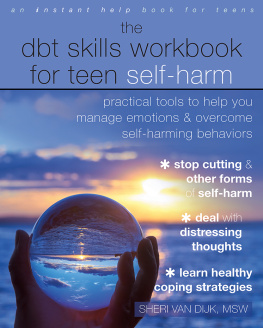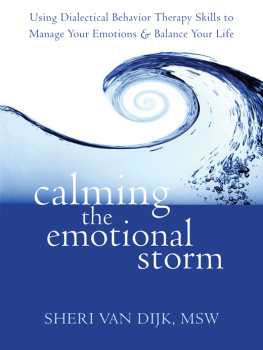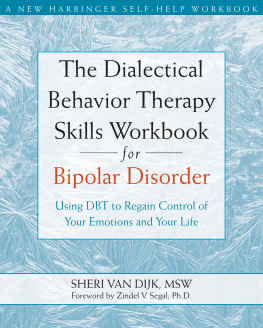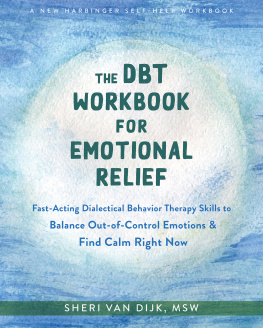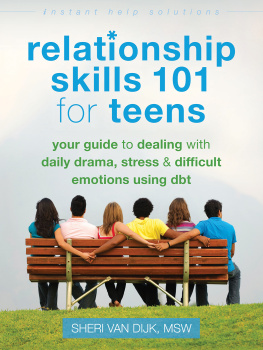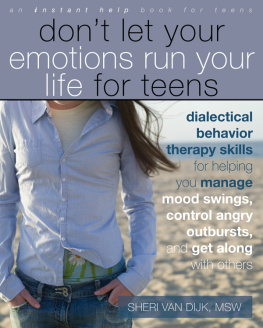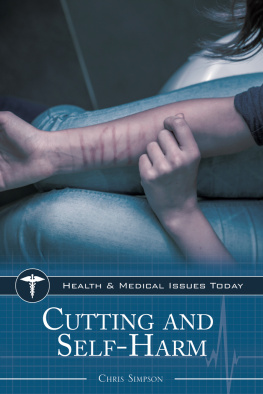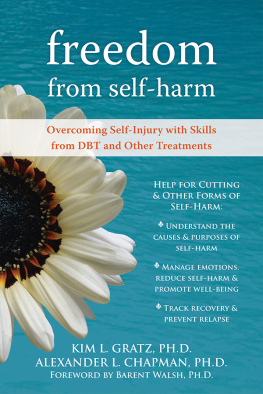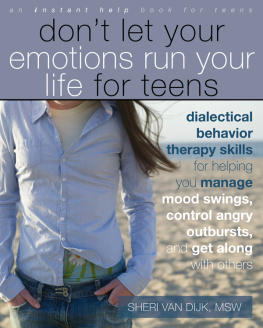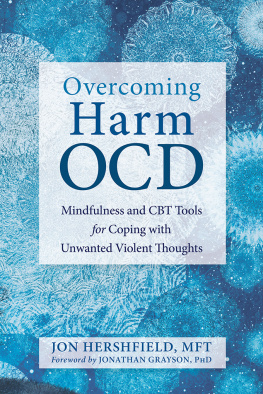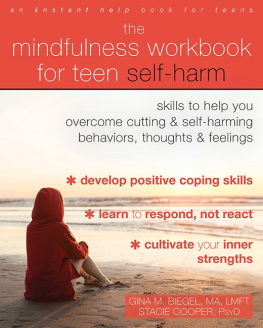I highly recommend this book for all teachers and parents to read. I have been teaching for more than thirty years and cutting is one of the biggest problems among teens. Ive seen many of my students struggle with this disorder. The problem is I havent found a reliable form of therapy for this disorder. Luckily, this book will help. It is based on dialectical behavior therapy (DBT) skills, and provides solutions and easy-to-follow strategies for those with self-harming tendencies.
Jackson Yee, MA , middle school teacher
Inflicting physical pain to release emotional pain can have debilitating effects on a teens life. With unparalleled expertise in DBT, Sheri gives you an easy-to-follow guide that enables readers to assess problematic coping patterns, and challenge self-harming behaviors in meaningful and lasting ways. Detailed examples validate personal experiences and demonstrate how to implement skills to reduce suffering.
Shivani V. Gupta MSW, RSW , clinical director at Oakridges Therapy Centre in Richmond Hill, ON, Canada
This warm, easy-to-understand workbook takes readers on a journey to understand why they may engage in self-harming behaviors, and teaches them healthier alternatives to manage their emotions. Sheri Van Dijk breaks down the practical strategies and skills offered in this workbook in a compassionate, nonjudgmental way. An essential tool for any teen struggling with self-harm!
Maggie Mullen, LCSW , culturally responsive social worker, national trainer, and author of The Dialectical Behavior Therapy Skills Workbook for Psychosis
In this engaging workbook, Van Dijk provides teens who self-harm with invaluable guidance on key DBT skills. The workbook will resonate with teens through vivid and youth-relevant examples, engaging exercises, and a clear and creative way of organizing and presenting the DBT skills. Teens will find wise guidance not only on how to overcome self-harm, but more importantly, how to build a life worth living. I strongly recommend this workbook for teens who struggle with self-harm.
Alexander L. Chapman, PhD, RPsych , professor of psychology at Simon Fraser University, president of the DBT Centre of Vancouver, and coauthor of The Borderline Personality Disorder Survival Guide
Sheri Van Dijk has done it again! This informative and practical book will be invaluable in helping people to understand why they engage in self-harming behaviors, and how they can use DBT skills to develop alternative responses to their emotional distress.
Greg Samuelson , registered nurse and registered psychotherapist practicing in Ontario, Canada; and founding member of the Canadian Network for Compassion Focused Therapy
This workbook provides an easy-to-use tool for teens engaging in self-harming and self-destructive behaviors. Parents, clinicians, and others within a teens circle of care will also benefit from the psychoeducation this book holds. The workbook uses teen-friendly language, illuminating stories, and engaging activities to explore healthier patterns of behavior. Used on its own or in addition to psychotherapy, this provides an excellent option for teens looking to improve well-being.
Michelle Brans, MA , registered psychotherapist with the Ontario College of Psychotherapists; clinical director of Counting Butterflies Child, Youth and Family Wellness; and psychotherapist in private practice specializing in teenage and emerging adult mental well-being
Sheri Van Dijk does a wonderful job explaining self-harming and self-destructive behaviors in non-shaming ways. She starts the book by saying that people engage in these behaviors for valid reasonsthey want to cope with painful experiences and emotions. However, we soon learn that there are more healthy and effective ways to deal with difficulties and pain. This book is well written and accessible for teens (and adults) who want to work through the skill-building exercises on their own or with a therapist. This workbook is helpful for those dealing with difficult life situations and painful emotions so they can live a healthier life.
Karma Guindon, PhD, RSW, CCFT , psychotherapist, consultant, and educator in private practice in Bolton and Newmarket, ON, Canada
Sheri does an exceptional job of outlining valuable skills; and describes a way for the reader to incorporate them into their lives. We can lose the power of a message with complicating theories and in-depth explanations. Sheri has managed to demonstrate incredible acceptance and validation, with positive and accessible directions for change; and she does so beautifully in print form. Within the learning and choices offered here, there is an invitation to pause and consider the options available. Well suited in both her choice of language, and balancing both text and worksheets. This workbook offers a path to recover from unhealthy coping, while learning how to emotionally regulate.
Leanne M. Garfinkel, MA, SEP , registered psychotherapist (CRPO)
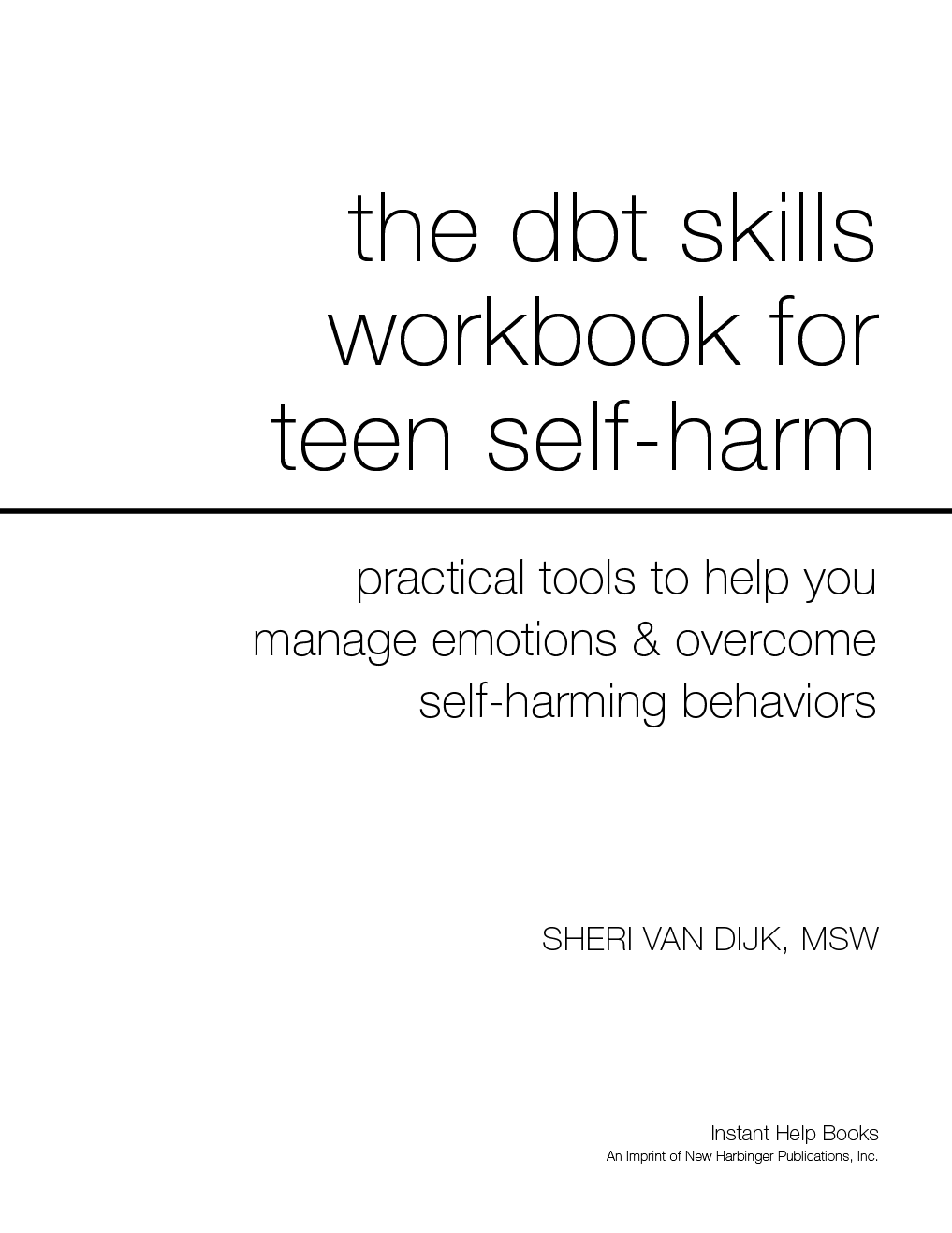
Publishers Note
This publication is designed to provide accurate and authoritative information in regard to the subject matter covered. It is sold with the understanding that the publisher is not engaged in rendering psychological, financial, legal, or other professional services. If expert assistance or counseling is needed, the services of a competent professional should be sought.
Distributed in Canada by Raincoast Books
Copyright 2021 by Sheri Van Dijk
Instant Help Books
An imprint of New Harbinger Publications, Inc.
5674 Shattuck Avenue
Oakland, CA 94609
www.newharbinger.com
INSTANT HELP, the Clock Logo, and NEW HARBINGER are trademarks of New Harbinger Publications, Inc.
Cover design by Amy Shoup
Acquired by Tesilya Hanauer
Edited by Karen Schader
All Rights Reserved
Library of Congress Cataloging-in-Publication Data on file
Firstly, this book is dedicated to my clients: thank you for allowing me to be a part of your journey and to be witness to the positive changes youve had the courage to make!
I would also like to dedicate this book to my family: Mom and Dad, Lisa, Roop, Caleb, Makenna, Jim, and Tess and Oliver. Thank you for always being there to support me. I love you all.
Contents
Introduction
You may already know that a lot of people self-harmdeliberately cause injury to their bodyso no, youre not crazy, youre not weird. There are actually many understandable reasons why people hurt themselves in different ways. But theres at least a part of you that also recognizes this isnt healthy or effective in the long term, or you probably wouldnt be reading these words. So, first of all, thank you for picking up this book, and congratulations for recognizing that self-harm isnt something you want to keep in your life in the long run.
The first goal of this book is to help you understand your behavior, whether its actually doing something to physically injure your body, like cutting or burning yourself, or doing something thats self-destructive, like abusing drugs or alcohol or having unprotected sex with people you dont know. The second goal is to teach you skills to help you deal with the things in your life that are causing you to turn to these unhealthy ways of coping with your pain and the hard stuff life throws at you.
This book is based on a treatment called dialectical behavior therapy (DBT), which was created by Dr. Marsha Linehan (1993), a psychologist in the United States. Her goal was to help people just like yourself, struggling with self-harming behaviors and urges, and even those who have thoughts of suicide. This workbook will teach you the skills you need to help you live a healthier life, where youll be able to make choices for yourself and have relationships with others that youll feel good about. Over time, healthier choices and positive relationships will help you start to feel better about yourself; in the long run, this usually helps people see that self-harming isnt something they want in their lives and helps them eliminate these behaviors.

